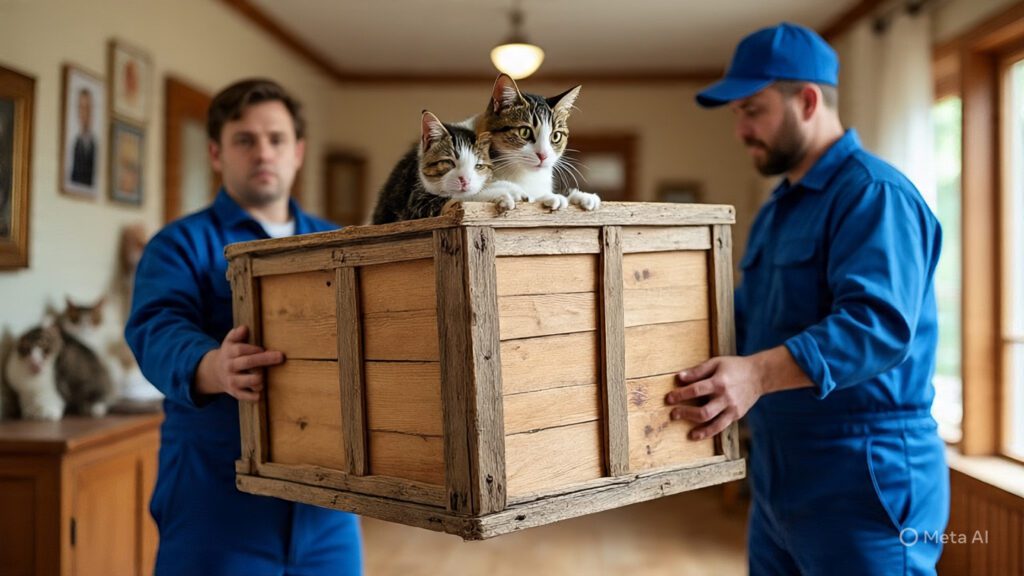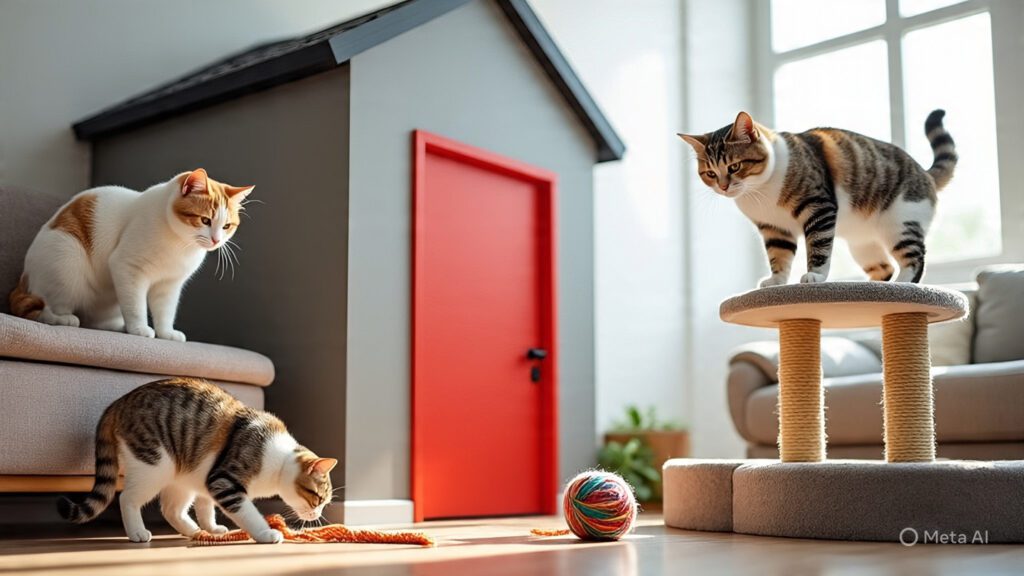Please Note: This post may contain affiliate links. If you click one of them, we may receive a commission at no extra cost to you. As an Amazon Associate, I earn from qualifying purchases.
Everyone engaged in moving might be stressed out, but our pets are the most affected.
Think about how your cat feels: one minute they're lying in a sunbeam, and the next they're taken away from everything they know to a strange new place full of boxes and unusual smells.
To be honest, it seems like being placed into an episode of “Survivor: Feline Edition.” What can we do to make this change easier on our cats? Let's go into some useful tips!
Top Takeaways and Key Concepts
- Acclimate your cat to its carrier well before moving day.
- Prepare a quiet room with familiar items for comfort during the move.
- Keep routines consistent for feeding, play, and rest to reduce anxiety.
- Introduce new spaces gradually, letting cats explore at their own pace.
- Use treats, toys, and calm interactions to reward bravery and build confidence.
Article Summary
The article explains how to reduce stress for cats during a move. Key strategies include acclimating cats to carriers ahead of time and preparing a quiet, familiar space during the move. Maintaining routines for feeding, play, and rest helps cats feel secure amid chaos. Gradual exploration of new areas, along with treats, toys, and calm interaction, encourages confidence and trust. Overall, patience, understanding, and gentle encouragement allow cats to adjust smoothly while strengthening their bond with their owners.
Handy Amazon Shopping Directory for Cat Supplies
Cat Food - Cat Toys - Cat Health - Grooming - Carriers - Cat Beds - Apparel
Furniture - Cat Doors - Collars - Feeding/Watering - Flea/Tick Control - Treats
Video Summary
Jump to Content
Getting Ready for the Move

Being ready is really important when you move with your cat. If you were suddenly taken from your comfortable couch and put in a strange place, wouldn't you want at least some warning?
The same is true for our cat companions! Before moving day, get them acquainted to their carrier. Put it in the living room where they can explore and sniff around without feeling like they have to stay there.
As moving day gets closer, you might want to keep your cat in a quiet room while everything else is going on.
If you plan beforehand, you can assist your cats not feel overwhelmed by the presence of strangers, like movers, in their space. Because cats are inherently territorial, seeing a lot of new people all at once might make them stressed and anxious. Also, loud noises from moving machinery or busy activity could make them run for refuge behind the nearest piece of furniture. Cats are funny that way. They see pandemonium and think, “It's time for a nap!” This instinctual reaction is how they deal with threats they think are in their environment.
It's important to get all of your cat's things ready ahead of time to make things easier. During the transfer, everything like food bowls, litter boxes, favorite toys, scratching posts, and warm blankets should be easy to get to. Having these familiar things close hand can help you feel safe during the chaos. Even when everything else seems out of control, the smell of their things might remind them that home is still close by.
While you're moving, think about setting up a quiet place in your new home where your cats may go to relax. To make this room a safe place away from the noise and activity, you should supply it with their needs. You give them the chance to become used to their new surroundings without feeling rushed or scared by letting them do it at their own pace.
Also, it's important to stick to a schedule throughout this time of change. Whenever you can, try to stick to regular feeding and play times. This will help your cats feel better about the fact that not everything has changed so much. Doing things they know can also take their mind off of things that are stressing them out.
Keep in mind that patience is important during this whole procedure. Change will affect each cat in a different way. Some may adjust quickly, while others may take longer to feel at home in their new home. You can help them feel less anxious and make the move to your shared living space go more smoothly by being there for them and understanding what they're going through.
In the end, trying to make your cats' lives less stressful during a move is good for them and makes your life as pet owners easier as you go through changes together!
Staying Calm During the Move

So, what happens on the day of the move? First, get a cat carrier and make sure Fluffy is safe inside so she doesn't get out while the moving parts are working hard.
Your Fluffy might be doing the Sydney Olympics 2000 in your living room if you don't do something about it! In any case, I think most of us would agree that trying to grab a fearful cat is like trying to catch smoke with your bare hands.
Don't forget to pet your kitties when you load the trolleys with a million cardboard boxes. They're probably in their carriers.
I know that cats don't always listen to directions the same way dogs do. Instead of obeying exact orders, they usually pay more attention to tone and inflection. You don't have to worry about how they act throughout a move because they will definitely hear your voice in the middle of all the noise. Even if they don't always reply the way we think they will, the sounds you know can help you feel better.
To make their transfer easier, you might want to invite a friend to remain with your cats while you get ready. Being with someone who is calm can help your cats deal with the changes going on around them. Cats are creatures of habit and feel better when things are known to them. Having another person there who knows them can help keep things normal.
Even the happiest cats might get frightened or upset during times of change like these. They might not entirely understand what's going on, but they can definitely feel the increased bustle and strangeness around them. A soft voice, familiar caressing, or just someone to keep them company can all help them feel better and lower their stress levels.
Make sure that their favorite toys or blankets are close by, and have someone stay with them. Cats feel safe when they can smell and see things they know. You might also think about playing gentle music or utilizing pheromone diffusers to relax your nerves. These things can help make the room feel more peaceful and less anxious.
Keep in mind that every cat reacts differently to changes in their surroundings. Some might hide at first but come out when they're ready. Others can be curious and want to explore straight away. You may help your cats adjust more easily by being there for them and understanding them during the process, as well as acknowledging their unique personalities.
Moving is a major shift for both people and their pets. Taking measures to lower their stress and making sure they have things around them that they are used to can help make this change easier for everyone!
Handling the Move: Making Their Space in the New Place

When you unlock the movable door, which is when Fluffy's big reveal happens, I suggest you clean up all the mess in Sydne.
Why? You should probably get your new flat ready for guests because those boxes appear like they are half unpacked and half a mess. You can progressively get your cats used to this new place.
First, make a unique space for your pets. It should be a modest area with their bed or blanket and food and drink containers around it.
This special space is like a safe haven for your cats, a place where they may go when the outside world gets too much for them. It's important to know that our cats might get stressed out when they are overstimulated, especially when things are changing, like when we move. So, letting them into just one room at first helps make the space more manageable so that they may get used to it at their own time.
It's interesting that, just as we do, cats do better when they have a place to be alone when they need to. This isolation isn't just about being alone; it's also about making them feel safe and in charge of their environment. Cats are naturally curious animals, but they also like having a quiet spot to watch without feeling like they have to interact.
Now, let's think about what these corners and parts of a room mean to a cat. We might think of them as just places to put our things or arrange our furniture, but for our furry friends, every nook and cranny is a possible hiding place or place to explore. Cats see things differently than people do. For example, an empty space could look like a snug den or an exciting area ready to be explored.
By understanding this different point of view, you may make their time in that area more enjoyable. To make them more comfortable, think about adding things that appeal to their natural tendencies, such climbing shelves or comfy beds hidden away in peaceful places. Giving them vertical space lets them look down on their territory while feeling safe in their chosen hiding place below.
Also, keeping the room clean and tidy will make it easier for your cats to move around and explore without being distracted by too many things. You might even slowly add some interactive toys or scratching posts so that they can explore new things at their own pace.
In the end, knowing how important personal space is for both you and your pets can make a big difference in how well your cats handle changes. You can help your cats feel more comfortable and confident as they get used to new places by making the space welcoming and respecting their need for privacy while also gently encouraging them to explore when they're ready.
Exploration and Change

You may claim that two to four hours is a reasonable amount of time to make changes. After about a day, let them look around the whole house, not just the area they were given.
It won't be a good idea to open doors too quickly because those cats have been in what could be seen as a vast area, and coming back to being under the sofas has never been the most pleasurable thing to do.
If they look fascinated or scared during these times of exploration, it would be crucial to pay attention to how they act.
It's fine if Winston wants to leave his basement for the first time and see what's under the bed. Every investigation is a step toward strengthening his confidence, even if it appears modest. Giving him the space he needs without making him interact can help him feel safer in his new home. Be patient; if he goes back into hiding, don't take it personally. Instead, wait for a time when you think he might be ready to look around again.
When Winston bravely goes a little further into his surroundings, think about giving him food or playing with him. This positive reinforcement might make him feel much more at ease and motivate him to keep exploring. Winston will learn that pushing out of his comfort zone can lead to fun and rewarding experiences, just like how kids are gently encouraged to face their concerns, like speaking in front of a crowd.
It's important to remember that this process isn't only about getting Winston used to new things; it's also about making memories that will bring you closer together during this time of change. Every time you interact with him in a good way, whether it's through play or giving him treats, you're not only helping him gain confidence, but you're also building trust between the two of you. As he goes through this new phase of his life, these shared experiences will become treasured recollections.
Also, think about adding different activities to your time with Winston. For example, making a little obstacle course out of pillows or toys might make exploring interesting and thrilling without being scary. He'll feel more accomplished and confident in himself as he successfully navigates these challenges.
Also, pay attention to your own energy during these times. Your calm approach can help Winston feel better by letting him know that there is nothing to be afraid of in the outside world outside of his safe areas. Speaking gently or using soothing gestures can make him feel comfortable and warm, which will make it simpler for him to explore new places at his own pace.
In the end, the road of discovery is just as vital as the end goal. You can create an environment where curiosity thrives by giving Winston the freedom to explore slowly and encouraging him along the way. Before long, he'll be confidently walking around your home instead of hiding in the shadows!
Suggested Resources:
How To Help Your Cat Adjust After Moving
https://www.catbehaviorassociates.com/how-to-help-your-cat-adjust-after-moving/
Tips For Moving With Cats
https://www.humanesociety.org/resources/tips-moving-cats
Creating A Safe Space For Your Cat
https://www.petmd.com/cat/centers/moving-with-cats-creating-safe-space-for-your-cat
Frequently Asked Questions
How can I prepare my cat for moving day?
Place the carrier out early so your cat can explore it and reduce fear. Familiarity before travel lowers anxiety and prevents negative associations.
Should I set up a quiet room during the move?
Yes. A calm room with familiar items gives your cat a safe retreat away from noise, movers, and chaotic activity.
Why is maintaining routines important?
Keeping feeding, play, and rest times consistent builds predictability, which helps decrease stress and confusion in a new environment.
How soon should I let my cat explore the new home?
Start with one small room, then gradually open additional areas once your cat shows confidence and relaxed body language.
Can treats and toys help my cat settle in?
Yes. Rewards and interactive toys reinforce bravery, encourage curiosity, and build positive emotional associations with the new space.
Should someone stay with the cat during moving day?
A calm familiar person can comfort your cat, offer reassurance, and reduce distress while heavy moving activity is happening.
Is hiding normal after arrival at the new home?
Yes. Hiding is a common safety response. Give your cat time, space, and gentle encouragement to explore at their own pace.

Kevin Collier is a dedicated feline enthusiast and expert contributor at CatFAQ.com, where he shares his knowledge on cat health, training, and overall well-being. With years of experience caring for and studying cats, Kevin provides insightful tips and practical advice to help cat owners nurture and understand their pets better. His passion for enhancing the human-animal bond shines through in his articles, making them a valuable resource for anyone looking to improve their cat’s quality of life. Whether it’s training techniques or health care tips, Kevin aims to empower cat owners with the information they need to ensure their furry companions thrive.

